Royal Pelargonium Varieties
- Ann Hoystead - up to 40 cm in height, with large inflorescences of dark red flowers, the upper petals are almost black due to large dark spots;
- Askham Fringed Aztec - up to 30 cm in height, flowers with deeply fringed white petals with purple strokes extending from the center;
- Black Prince - up to 40 in height, dark plum flowers with silvery rims along the edge of the petals;
- Bredon - up to 45 cm in height, with ruffled, dark red flowers, with black-purple feathers on the upper petals;
- Bushfire - up to 50 cm, bright red flowers, with a dark spot on the petals;
- Carisbrooke - up to 45 cm in height, flowers are light pink, with marble spots and strokes on the upper petals;
Funchal - the light pink color of the edges of the petals turns into bright pink, and then into a dark crimson spot in the center;
- Georgina Blythe - up to 35 cm, with large, bright orange-red flowers with burgundy veins, with lighter lower petals, white at the base;
- Joy - up to 45 cm, with reddish-pink flowers 4.5 cm in diameter, with a white neck and ruffles along the edges of the petals, reminiscent of primrose flowers;
- Lavender Grand Slam - up to 40 cm in height, with mauve flowers, upper petals with dark purple feathers;
- Lord Bute - up to 45 cm, flowers of a deep wine color with pale pink edging of petals, torn along the edge;
- Margaret Soley - up to 30 cm, with large flowers up to 6 cm in diameter, with light red petals with a dark red spot (larger on the upper petals), with scarlet edging around the spot, with a network of dark veins, wavy along the edge and slightly swirling;
- Morwenna is a compact variety with very large, satin, black - wine, laced along the edge of the petals, flowers;
- Rimfire - with large black-burgundy flowers with a lighter red wavy edge and a network of dark veins;
- Sefton - up to 35 cm in height, with bright red flowers that have a dark red-purple spot in the center of the petal;
- White Glory - up to 45 cm, with lush inflorescences of large pure white flowers without streaks and spots up to 7.5 cm in diameter.
Candy Flowers is a series of varieties designated Pelargonium grandiflora, bred by the German company Elsner Pac by crossing Pelargonium royal and Pelargonium of the "Angels" group especially for outdoor cultivation. According to the growing conditions, it is closer to the angels. This series is characterized by earlier flowering than royal pelargoniums, does not require cold winter maintenance, continues flowering at high temperatures and strong insolation. The flowers are larger than those of the "angels", abundant.
- Candy Flowers Bicolor (Cambi) is a pale pink bicolor variety with a bright pink spot on the petals and veins.
- Candy Flowers Bright Red (Camred) - a variety of the same series of radiant cherry red with a fuzzy black spot on the petals;
- Candy Flowers Dark Red (Camdared) - a variety of the same series with velvety dark red flowers with a black spot on the petals, the inside of the petals is lighter.
Characteristics of species and varieties
Several intraspecific groups can grow at home:
- The ampelous species has a creeping stem that does not grow upward. Feature - cascading foliage. The plant is ivy-like, hanging down, used to decorate the garden;
- The zonal view is distinguished by its endurance. Its height reaches 80 cm. The foliage of the species is dark, with a smooth transition to light colors. The fluffiness of the leaves is considered a feature. The most popular variety that is not planted outdoors. The plant, although hardy, is still demanding;
- The dwarf (miniature) species is distinguished by the compactness of the bushes. There is no need for shaping. This variety is preferred to grow not only in the open field, but also in limited areas. Flowers look very impressive in small pots, since the flowering is abundant, small lush bushes are formed. The plant is relatively picky in content.
Each of these subspecies has many different varieties, which differ in color, shape of buds and features of content. The most popular are the Pelargonium rosebud varieties Red scarlet, Rosebud supreme, Arctic, Snow and many others.
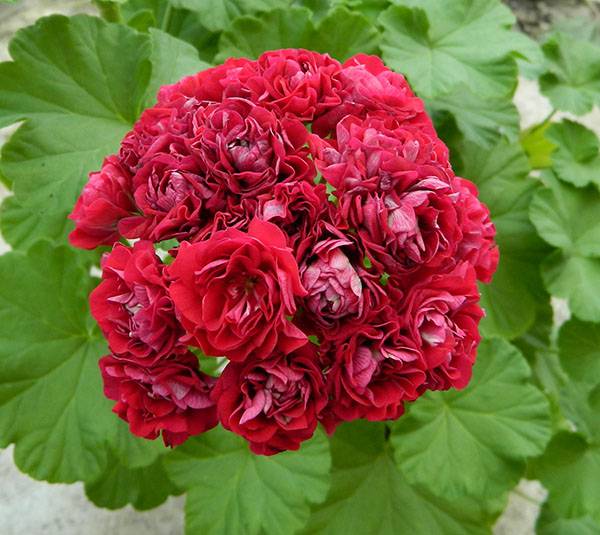
Rosebud variety Red scarlet
It is necessary to consider the description of popular varieties:
- Vectis rosebud is a small-looking, mature shrub that looks attractive. A good option for shaping. The main advantage is considered to be abundant, long flowering. The bud is bright red. The inside of the flower petals is darker than the outside;
- Pelargonium Rosebud Supreme - blooms with bright crimson, thick, double buds. The inside-out bud differs in color. The underside of the bud is white, which looks unusual. Bushes are straight, strong. The inflorescences of Rosebud supreme pelargonium are dense, bloom for a long time, with proper care, flowering can be extended for the whole year;
- Pink rambler is one of the popular varieties. A bright and lush bush with corrugated leaves. The flower bud is bright pink with red impurities. The front side is lighter;
- Margaretha pelargonium is a variety of royal geraniums used exclusively for decorative purposes. The blooms are arranged in several rows, which in appearance resemble small bouquets of unopened roses. The foliage is distinguished by curly outlines resembling a border. The height depends on the location and can reach 80 centimeters;
- Red pelargonium Rosebud red is a plant with red double inflorescences. Differs in long and abundant flowering. The inflorescences themselves are thick, lush, dense. No need to form bushes. Optimum temperature for growing: 25 degrees in summer, 15 to 20 degrees in winter. The flower is grown indoors;
- Pelargonium baby rosebud is a compact plant. The buds are red in color, with a faint crimson tint, white in the middle. Leaves are inconspicuous, of the usual shape;
- Beverly park pelargonium is distinguished by large flower buds, double, apricot color. At the edges, the color of the inflorescences is lighter. The leaves are green, darken towards the center.
On a note. Regardless of the type and variety chosen: Pelargonium Rosebud Superior, Vectis rosebud or Pelargonium Baby Rosebud, they need proper care, which will extend the flowering period.
Pelargonium Appleblossom: description of varieties and cultivation
For almost 200 years, Appleblossom pelargoniums have been decorating our lives with their wonderful blooms.
Description
Apple Blossom means "apple blossom" in Russian. Thanks to skilful breeders, to the delight of lovers of these flowers, not only pink pelargoniums, reminiscent of the picturesque flowering of spring gardens, have appeared in the world, but also many other varieties of stunning beauty.
Pelargonium Fischers Appleblossom. It is a magnificent rosaceous rosaceous variety of Pelargonium. Delicate pink inflorescences with peach or red edging are collected in lush clusters on elastic short peduncles. Blooms profusely from May to August.
"Fisher" branches well, has dense large stems, rather compact. It propagates vegetatively, with side shoots with five leaves. Loves light and warmth.
Ungarisk Appleblossom. Zonal rosaceous pelargonium with bright red velvety petals with lilac edging and white seamy side. The inflorescences are distinguished by their splendor and density, endowed with a high peduncle, they look elegant and solemn. The bush is large, powerful, branched, has emerald foliage with pronounced zones.
"Ungarik" is a demanding variety that needs warmth, good lighting and shaping a bush. To see the first flowering, you need to be patient: the plant may not bloom in the first year of life.
Rosebud Westdale Appleblossom. It is a rosebud pelargonium, which has leaves of unusual color with a green central zone and a large, light-milky edging along the edges.The flowering of the plant is no less amazing: the flowers are white, double. They look like half-open roses with a pale pink or red border.
This noble plant does not require special attention, it feels great on the street and at home.
Growing
Peculiarities:
- the flower is grown in spacious pots, but not outdoors;
- Pelargoniums do not tolerate bad weather - gusty wind, rain, cold and fog are destructive for them;
- flowers love the sun, but you should not leave them in the heat under the incinerating rays;
- in winter, most varieties are dormant, they lose their decorative effect, stretch out and stop blooming;
- it is not advisable to place plants next to heating radiators in winter;
- from the beginning of the growing season, the bushes must be shaped by competently cutting the shoots;
- faded roses must be removed - then the whole bunch will continue to bloom;
- fertilize rosebud pelargoniums with phosphorus-potassium fertilizers.
Pelargonium Apple Blossom Rosebud: what you need to know about the variety
Apple Blossom Rosebud is one of the most attractive rosaceous varieties of the zoned Pelargonium group. It is appreciated not only for its high decorative effect of flowering, but also for its unique unpretentiousness, which allows you to grow the bush in indoor conditions. Like other geraniums, Apple Blossom Rosebud requires proper care and conditions.
Apple Blossom Rosebud: description and features of the variety
The first plant of the Apple Blossom Rosebud variety was obtained in 1948 as a result of long-term breeding work. This rosaceous pelargonium is rightly considered the star of any collection due to the beauty of the inflorescences, the color of which seems to be truly watercolor. Inside, the buds are highlighted in light green, the central part of the petal becomes pure white, and a pale pink border is located along the edge. The caps form dense, keep freshness for a long time, due to which budding can last all summer (see photo).
The intensity of the color of the buds, as well as their size, depends on the temperature conditions of detention. In the summer, when under the sun's rays, the flowers acquire a bright pink border with a smaller diameter of flowers, in the fall the colors cannot boast of saturation, but the buds increase in size. The variety does not shower petals - the buds slowly dry up on the peduncle, turning into a "herbarium".
Apple Blossom Rosebud belongs to the varieties that require constant molding. To obtain a lush crown, pelargonium must be regularly cut and pinched so that the lateral buds wake up. If the development of cuttings is allowed to flow, Appleblossom Rosebud will grow into one trunk and turn into a real palm tree, which will definitely not add decorative effect to it.
The diameter of the Apple Blossom Rosebud leaves is impressive - in most cases the plate reaches the size of an average palm, and for this feature the variety has received the status of a "horse" among flower growers. The rather large crown of pelargonium requires appropriate conditions of detention - the plant prefers well-lit window sills, regular feeding during the active growing season and good watering.
Rules for growing pelargonium Appleblossom Rosebud
Apple Blossom Rosebud needs typical conditions for zonal pelargoniums, that is, good lighting and warm content, nutritious, but at the same time loose, permeable substrate.
Thus, the cultivation of Apple Blossom Rosebud pelargonium boils down to several points:
- Lighting. It is preferable to have well-lit window sills, which "fall" under the sun for several hours a day. On the southern side, it is advisable to shade the pots so that the leaves do not suffer from burns; it is better not to grow them on the northern windows;
- Watering. It is necessary to moisten the soil constantly, as the upper layer of the substrate dries, but always moderately. The earthen lump should neither dry out nor swamp;
- Pruning. To obtain a compact bush with a harmonious crown, pelargonium must be cut off.Strong shortening of shoots is carried out at the end of February, sanitary pruning - as needed. Pinching of the apical and lateral cuttings is also required;
- Top dressing. During the budding period and during flowering, Appleblossom Rosebud must be fed using fertilizers for Geraniums or compositions for flowering indoor plants.
Like other zoned pelargoniums, Apple Blossom Roseboud loves fresh air and ventilation, but reacts negatively to drafts. For this reason, with the onset of warmth, the bush is taken out to the balcony, veranda or loggia, creating flower arrangements and always returning it to the apartment before the cold weather.
The optimum temperature for growing and flowering Apple Blossom Rosebud is between + 17- + 23 degrees. When the temperature drops below +12, the plant stops developing and often dies from hypothermia of the root system.
Apple Blossom Rosebud will adorn your windowsill with lush blooms when grown properly.
Peculiarities
Pelargonium belongs to the Geraniev family. The homeland of the plant is South America. Some varieties also grow in the African continent, Australia and other tropical areas. The flowers of pelargonium are large, with an elongated sepal, in appearance slightly resembling the beak of a crane or a stork, for which the plant got its name Pelargonium, translated from Greek as "crane nose".
The color of the flowers has an extensive palette, and depending on the variety, it can vary from light, almost white, to dark purple, almost black.
Amateur flower growers appreciate pelargonium for its luxurious appearance and long flowering period. In addition, this plant is not capricious and does not require any special care. However, pelargonium is appreciated not only for its visual appeal. It has a lot of useful properties. So, an infusion of the leaves of this plant normalizes blood pressure and soothes. The flower compress heals open wounds and speeds up the healing process.
As mentioned above, pelargonium belongs to the Geraniev family, therefore the two cultures are often confused with each other. Meanwhile, there are differences both in the shape of the flower and in the size of the plant itself. In 1738, the Dutch scientist Johannes Burman first separated these two names, however, another scientist, botanist Karl Linnaeus from Sweden, in 1753 in his scientific work "Plant Varieties" challenged this statement and combined the two flowers into one group.
Disputes about this do not subside to this day. Meanwhile, those flowers that grow everywhere in almost every home are pelargoniums. Unlike geranium, which feels great even at sub-zero temperatures, pelargonium is very thermophilic and does not hibernate in the open field.
Pelargonium Appleblossom: description of varieties and cultivation
For almost 200 years, Appleblossom pelargoniums have been decorating our lives with their wonderful blooms.
Apple Blossom means "apple blossom" in Russian. Thanks to skilful breeders, to the delight of lovers of these flowers, not only pink pelargoniums, reminiscent of the picturesque flowering of spring gardens, have appeared in the world, but also many other varieties of stunning beauty.
Pelargonium Fischers Appleblossom. It is a magnificent rosaceous rosaceous variety of Pelargonium. Delicate pink inflorescences with peach or red edging are collected in lush clusters on elastic short peduncles. Blooms profusely from May to August.
"Fisher" branches well, has dense large stems, rather compact. It propagates vegetatively, with side shoots with five leaves. Loves light and warmth.
Ungarisk Appleblossom. Zonal rosaceous pelargonium with bright red velvety petals with lilac edging and white seamy side. The inflorescences are distinguished by their splendor and density, endowed with a high peduncle, they look elegant and solemn. The bush is large, powerful, branched, has emerald foliage with pronounced zones.
"Ungarik" is a demanding variety that needs warmth, good lighting and shaping a bush. To see the first flowering, you need to be patient: the plant may not bloom in the first year of life.
Rosebud Westdale Appleblossom. It is a rosebud pelargonium, which has leaves of unusual color with a green central zone and a large, light-milky edging along the edges. The flowering of the plant is no less amazing: the flowers are white, double. They look like half-open roses with a pale pink or red border.
The plant blooms very luxuriantly all season with magnificent large caps. The bush itself is tall, powerful, looks decorative.
Westdale loves partial shade, diffused light and warmth. The plant is demanding for watering: it does not tolerate dry air and soil, does not tolerate waterlogging and drafts. It is difficult to please him. As a sign of his dissatisfaction, the "capricious" always strive to shed the leaves.
Knight Appleblossom F1. This is a zonal, very unpretentious, beautiful hybrid variety that blooms all year round in the house, and in the warm season (from May to September) - on the street. The flowers of the plant are pink-carmine, with a light pink center. The magnificent, unusual color of the foliage has a cherry-brown hue with a bright green edge.
"Knight" is a large, branched and lush bush. The plant loves light, but can bloom beautifully in shaded areas, is patient with drought. Loves good and regular watering. Feels great not only on the southern, but also on the western or eastern windows.
Happy Appleblossom. This pelargonium is the pride of any grower. Against the background of leaves with a central zone in the shape of a light green butterfly, huge pink-white caps of inflorescences of delicate roses rise on tall, slender peduncles.
The bush requires care, loves the sun, regular but moderate watering. It is necessary to form the crown of the plant, otherwise the shoots will stretch out and look like straight sticks, do not branch. Cuttings cut during the cutting of the bush root perfectly.
Exotica Appleblossom. Not small, but very compact bush, with dense, pale pink double roses. The variety differs in that it blooms elegantly and for a long time. In bright summer light, the petals can take on a creamy or salmon color. Bright light greens are in great harmony with lovely voluminous pink-shaped inflorescences.
Apple Blossom Rosebud. An ancient variety that every collector who is in love with rosebud pelargoniums has. With its sophistication and beauty, Apple Blossom Rosebud won the heart of Queen Elizabeth of England. Graceful roses, collected in an inflorescence-bouquet, have a white center with a light green tint and creamy petals, smoothly turning into a rich pink hue. The bush is strong, with fleshy thick stems and delicate, light green foliage.
This noble plant does not require special attention, it feels great on the street and at home.
Regular haircuts, timely watering and warmth are all you need for a chic and long-lasting bloom.
Advantages and disadvantages of the variety
We suggest that you familiarize yourself with the description of especially popular varieties, as well as see photos of plants whose flowers resemble roses.
Refers to the zonal miniature type. Has beautiful double flowers. At the beginning, the flowers bloom in white, as they ripen, they acquire a pink tint. In one inflorescence cap, there can be two colors at once - white and pink, which gives a special sophistication and beauty. The inflorescences are small, but tightly planted. Abundant flowering during the summer season.
Supreme
The Rosebud Supreme plant differs from other species by a very late onset of flowering, but having entered the flowering season, it dissolves a huge number of inflorescences, each of which outwardly looks like a ball covered with small rose buds of a beautiful red color. The bush of the plant is powerful, strong, tall.
The Apleblossom rosebud plant grows very quickly and, without careful and frequent formative pruning, grows into a long, powerful bush.The plant blooms magnificently. Inflorescences are distinguished by their originality of color. In the middle there are green-white petals, then the color changes to white, and the edges are pale pink.
Vectis
The bush of this species is compact, lends itself to easy formation, and the flowering is long, abundant. With the beginning of spring, inflorescences form, turning into flowers of a rich red color. The outer side of the petal is much lighter than the inner one. The plant blooms for a long time, retaining the uniqueness of the form throughout the entire flowering period.
Pink Rambler
This variety of zonal pelargonium is the most famous. The bush is unpretentious to care for, has a powerful structure and lush, abundant flowering. The flowers are bright, carmine pink, the foliage is rich, corrugated. The seamy side of the petal is lighter. Pink begins to form inflorescences a little later than pink-flowered zonal plants, but compensates for this with continuous flowering throughout the season.
Red (Red)
Flowering is very long, from May to September. The color of the petals can be monochromatic or have a color in the form of spots, strokes, stripes. The shoots of the plant at the base acquire a tree-like appearance, the leaves are dense, pubescent on the front side.
Pests and parasites. Aphids or whiteflies can settle on a pelargonium bush. The parasites will suck out all the juices from the plant, which will lead to the death of the plant.
It is important to treat the bush with insecticides. Plant disease
Most often, the plant is spoiled by gray mold.
Plant disease. Most often, the plant is spoiled by gray mold.
When mold develops, it is important not to water the flower. Yellowing and drying of leaves
The plant lacks moisture. The water may not be reaching the roots. Mulching will help
Yellowing and drying of leaves. The plant lacks moisture. The water may not be reaching the roots. Mulching will help.
The leaves are lethargic, falling off. Excess moisture. Thinning the plants can help.
Does not bloom. This may be due to a lack of light and feeding.
It is important to ensure the presence of a bright diffused color and regularly apply mineral fertilizers for flowering plants.
The flowers dry up. Perhaps a fungus has started. Treatment with Fitosporin or watering with 5% Bordeaux mixture will help. The presence of rusty, gray spots, white fluff on the leaves may also indicate a fungus.
It is important to provide loosening of the soil, for air intake and antifungal treatment
Bacterial contamination. Brown spots will appear on the plant
It is important to transplant into another soil, apply fungicides
Compared to Denise, Pelargonium Fisher has the following advantages:
- a larger bush;
- the plant is better to branch;
- tolerates diseases well;
- the flower is 1.2-1.3 times larger.
Among the disadvantages are the following:
- stops blooming in the heat or in the shade;
- you need to correctly form a geranium bush;
- Fisher is susceptible to attack by garden pests.
Varieties of rosebud pelargonium
Exotica Appleblossom Rosebund cultivar
A kind of rosaceous umbellate pelargonium.
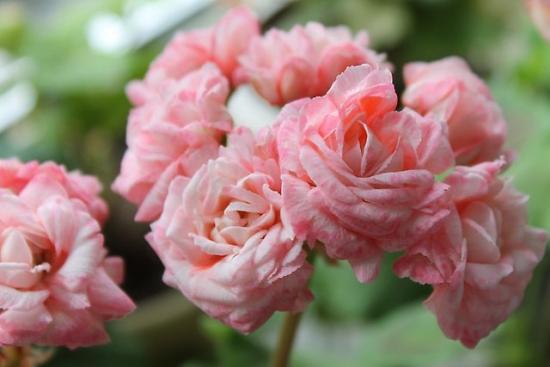
Differs in sufficient compactness of the bushes, blooms with large, dense inflorescences, does not fade for a long time. The shape of the flowers is reminiscent of roses. The flowers are delicately creamy in color with a slight pale pink blush.
Horizon Star variety
Refers to zonal pelargonium.
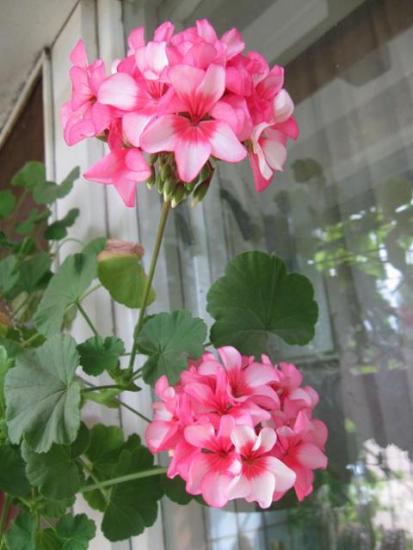
The bush is compact. A hybrid with large, simple flowers, the diameter of which is about 4 centimeters. White-pink, with a red-coral eye in the center, the flower, with a coral-colored border along the edge of the petals, resembles a phlox flower.
It blooms early and abundantly. The bush is decorated with umbrellas of large inflorescences. The foliage is colored bright green.
PAC Viva Rosita variety
Has gained popularity among flower growers.
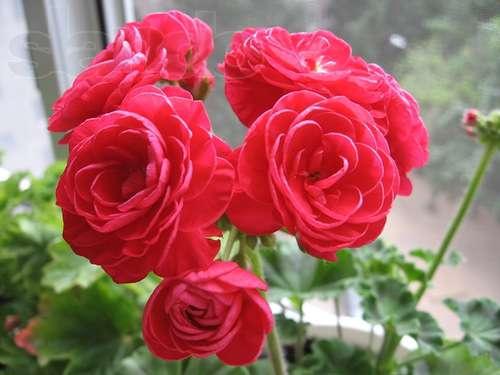
A compact bush of a plant, gives many shoots for a long time and blooms profusely. In the inflorescence up to 20 double flowers. The diameter of one flower is up to 6 centimeters, which are painted in crimson red.
More about pelargoniums - when watching the video:
I think this spring happy appleblossom rosebud pelargonium will be planted in our country house. A volitional decision was made after reading this material. And this is correct, as it is clearly and well written.
Growing problems, diseases and pests
When breeding geraniums, there is a risk of rot or viral infection. It can also suffer from pest attacks.
How to deal with them
To prevent the appearance of diseases, you need to use fungicides - Fitosporin, Fundazol. To prevent insect attacks, insecticides are used - Calypso or Aktara.
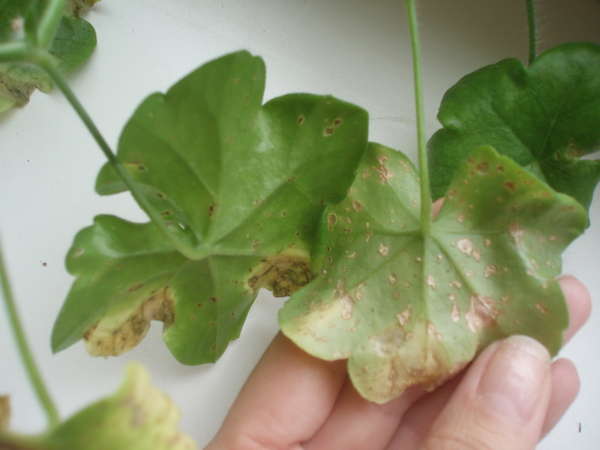
With the development of diseases, the leaves become stained.
Pelargonium Fischers Appleblossom is very popular with flower growers. In order for the bush to bloom and develop magnificently, it needs full care. It should include the correct watering regime, pruning, feeding.
Fischers Appleblossom Pelargonium Care
Geranium hybrid plants are popular because they have a very beautiful flowering, bright shades of leaves, compact bushes. But so that they do not lose their qualities, they need constant care. These plants will stretch out their stems if they grow in a dimly lit room. It is imperative to follow the shape of the crown of plants: in spring and autumn, carry out the formation of a bush, cut and thin out old and deformed branches, shorten shoots, remove dried peduncles and leaves.
Pelargoniums at the time of flowering need regular watering with settled, rain or spring water at room temperature. Every two weeks in spring and summer, flowering plants in the root zone after the main watering are applied with solutions of complex fertilizers.
Important! Without top dressing, the plants will stop growing and will not be able to form flower buds. In spring, summer until mid-autumn, pelargoniums bloom actively. From mid-October to the end of February, plants need to be placed in cool rooms so that they stop their development and can take a break from active processes.
During this period, the flowers are not fed, they are watered when the soil in flower pots dries up by 1/3
From mid-October to the end of February, plants should be placed in cool rooms so that they stop their development and can take a break from active processes. During this period, the flowers are not fed, they are watered when the soil in flower pots dries up by 1/3
In spring, summer until mid-autumn, pelargoniums bloom actively. From mid-October to the end of February, plants should be placed in cool rooms so that they stop their development and can take a break from active processes. During this period, the flowers are not fed, they are watered when the soil in the flower pots dries up by 1/3.
For your information! So that the plants do not get sick and do not suffer from pests, biological products are used for prophylactic purposes designed to combat rot and viruses, insect larvae. These can be foundazol fungicides, ridomil gold, phytosporin-M, insecticides aktara, fas, calypso.
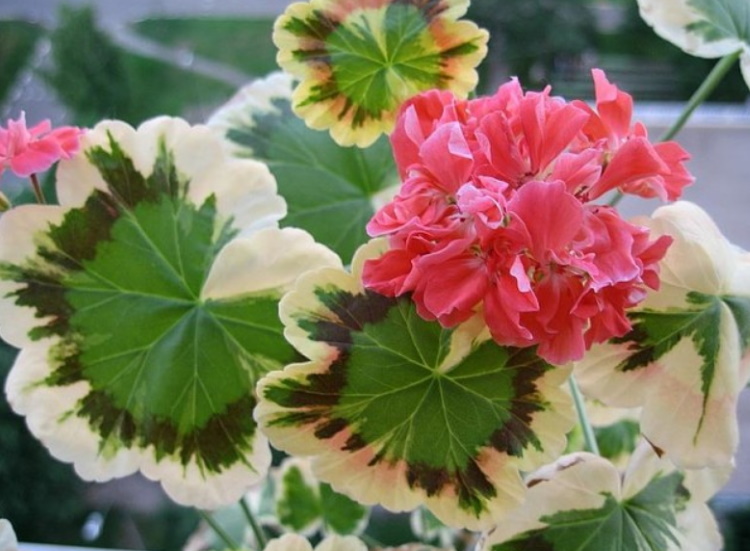
Zonal variegated pelargonium
The propagation of hybrid plants cannot be carried out with the help of seeds, many novice amateur flower growers regret this very much, because not everyone immediately succeeds in rooting a stalk of geranium or pelargonium. But this is worth learning in order to be able to admire such beautiful flowers as Fischers Appleblossom pelargoniums.
Pelargonium Apple Blossom Rosebud
Apple Blossom Rosebud Pelargonium is considered the Queen of England's favorite variety. This is an important detail in every bouquet. Some believe that the plant has been around for over two hundred years. Although there is an alternative opinion that this variety was bred only in the forties after the war. The flower has such a unique inflorescence that it bewitches the eye. They look like little roses. In the very center, the color is green-white, a little further from the middle is pure white, and the edges of the flower are pink.
Description of the variety
Pelargonium Apple Blossom appeared in South Africa. Back in the seventeenth century, the flower was brought to Europe. A hundred years later, gardeners singled it out as a separate variety.It is believed that the species arose by chance, by an unexpected mutation. Then he reached the present form when he crossed with other varieties (approximately this happened in 1870).
Rosebud is considered a terry plant. The appearance of the inflorescence resembles a pink bud, which is about to open completely. Geranium is often confused with a rose growing on a bush. That is why it is called rosaceous pelargonium. But flowers differ from a rose in their leaves.
Pelargonium Apple Blossom Rosebud
Pelargonium Apple Blossom is a light-loving perennial plant. It is worth highlighting several points that characterize this inflorescence related to geraniums:
- the rhizome of the flower is dense;
- the plant has a herbaceous and tough stem, which often woody from the root in older species;
- the leaves look like circles with a cutout not exceeding a third of the width;
- the fruit of the flower is in the form of a box;
- propagates by seeds, cuttings, by dividing bushes;
- loves warmth.
Important! Water the plant abundantly, but not often. There are no thorns on the stem
The inflorescence looks like a ball, for the beauty of which flower growers, even beginners, want to have this particular flower in their garden
There are no thorns on the stem. The inflorescence looks like a ball, for the beauty of which flower growers, even beginners, want to have this particular flower in their garden.
In winter, Apple Blossom Rosebud pelargonium does not look pretty at all. The stem becomes bare, as the leaves turn yellow and fall off, and there is no flowering at all. The bred geranium variety blooms all the time, with the exception of cold weather. The seeds are large, they can be collected and planted in a cup in the fall, in order to transplant the sprout into the ground in the spring. The plant is quickly adopted and begins to bloom immediately.
Many inexperienced flower lovers use incorrect plant names:
- pelargonium Appleblossom rosebud;
- Pelargonium Apleblossom rosebud;
- pelargonium Appleblossom.
Features of growing
Caring for Apple Blossom Pelargonium Rosebud is simple, since the flower is unpretentious. It does not need to be watered often, it grows well on the sunny side of the windowsill. Without light, the leaves turn white and fall off, the stem becomes longer, the formation of flowers does not occur.
Important! For this look, you need to choose a small pot. This is due to the fact that the roots are not very branched, so they cannot master the entire volume, the soil begins to acidify, which will lead to the death of the plant
It is necessary to ensure that the ground is good for air and moisture. Therefore, you should make a potting mixture from:
This is due to the fact that the roots are not very branched, so they cannot master the entire volume, the soil begins to acidify, which will lead to the death of the plant. It is necessary to ensure that the ground is good for air and moisture. Therefore, you should make a potting mix from:
- small expanded clay;
- coconut fiber;
- fertilizers in granules.
You cannot overdo it with fertilizer, you need to use the dosage indicated on the package.
You should also add loam and sand, which retain moisture. Everything is put in equal proportions. Watering is necessary rarely, but abundantly. In this case, the water must be hard.


